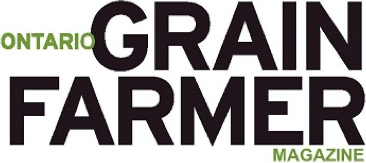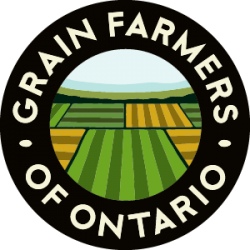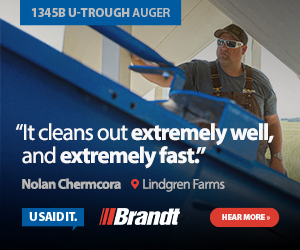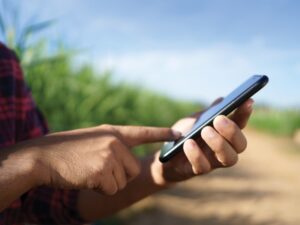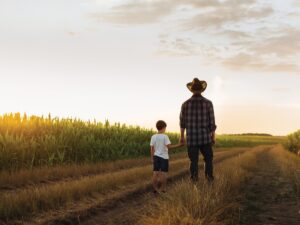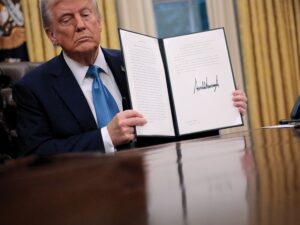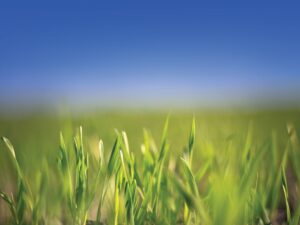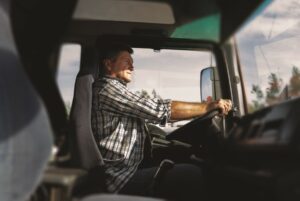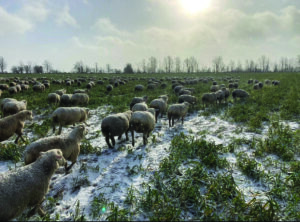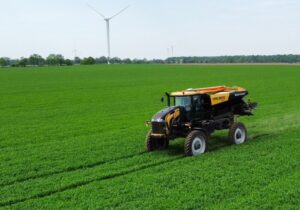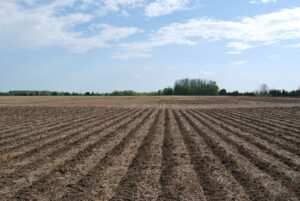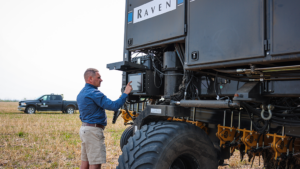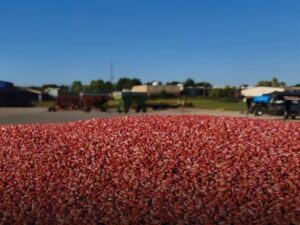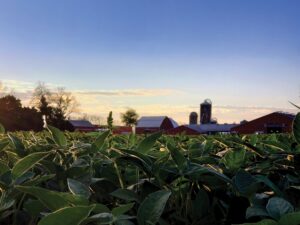Field Observations
FALL 2025
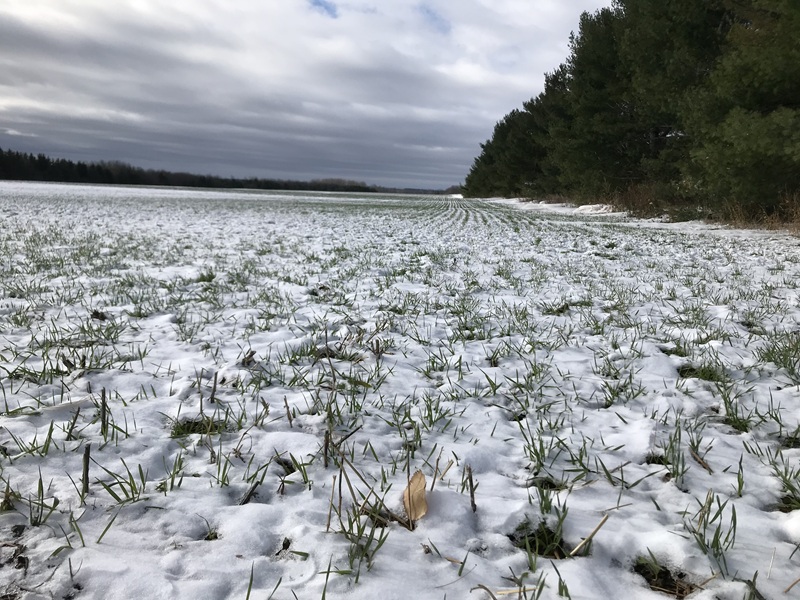
November 27, 2025
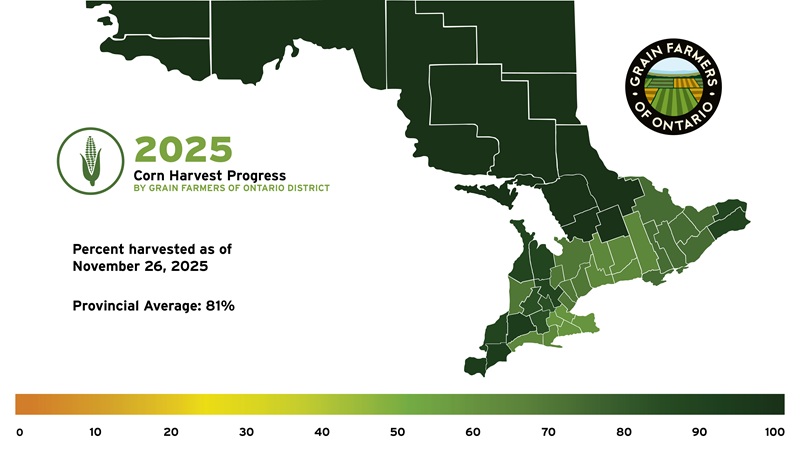
As November comes to a close, corn harvest is also closing in on completion as weather allows. Field preparation has been occurring to manage residue and prepare fields for the next season. Winter wheat is reaching dormancy if it hasn’t already, as the temperatures remain below 9c.
Field Progress – Grain Farmers of Ontario’s weekly estimation of planting and harvest across the province, by district, shares that corn harvest is 81 per cent complete.
GrainTALK Webinar series on soil fertility
View the recent GrainTALK Webinar series on soil fertility. Each webinar features industry experts addressing a variety of soil fertility topics.
- The first webinar covers the how, why and when of soil sampling.
- The second webinar is focused on interpreting results, turning analysis into recommendations, credits for manure and cover crops, and tools to use.
- The third webinar shares how to take a recommendation and turn it into a fertilization plan.
The three-part series can be viewed here.
November 20, 2025
Rain, snow, and ice made corn harvest stagger the past couple of weeks, as the middle of November arrived.
Corn
Field Progress, Grain Farmer of Ontario’s weekly, district-specific estimate of planting and harvest across the province, reports that corn harvest is 63 per cent complete as of November 19, 2025.

Yields for corn harvest have ranged from below- to above average, depending on the region and weather conditions experienced. Harvest moistures are higher than some years with corn coming off in the 24- to 40 per cent moisture range.
The importance of correct sampling for DON testing cannot be stressed enough. Ensure that at least four probe samples per load are being taken from bins, wagons or trucks. If you’re using the tailgate dip option, sample several times – 200 dips of the bucket through the grain stream is the gold standard.
At least two kilograms of grain should be sampled and ground for DON testing. Ensure that the grain is ground finely enough that 95 per cent of the material goes through a 20-mesh screen. Once the grain is ground and uniformly mixed, a subsample can be used to do the DON dip test. This will ensure a more reliable and repeatable DON level measurement.
For more information on testing for DON, view the Grain Farmers of Ontario Testing for DON Factsheet or this video.
Soybeans
A few soybean fields are still out in some areas. Producers are waiting for the ground to freeze before continuing, to avoid the field getting too rutted up by equipment and to avoid mud tags on soybeans.
GrainTALK Webinar series on soil fertility
The GrainTALK Webinar series on soil fertility hosted its third and final webinar this week. Each webinar features industry experts addressing a variety of soil fertility topics.
- The first webinar covers the how, why and when of soil sampling.
- The second webinar is focused on interpreting results, turning analysis into recommendations, credits for manure and cover crops, and tools to use.
- The third webinar shares how to take a recommendation and turn it into a fertilization plan.
The three-part series can be viewed here.
Post-harvest evaluations and assessments
Now that harvest is wrapping up, it’s important to look back over the year and consider these points:
- Did seed treatments work well?
- Was there a particular weed that was troublesome to control?
- Would a fungicide application have improved plant health?
- Could a certain management practice be implemented or improved?
Also consider the quality of grain at harvest. Make note of any major grain concerns such as moisture, insect or disease damage. Were pods and cobs full, or was something lacking that caused reduced yields that could be controlled in the future?
If you have access to yield maps, use them for more than seeing field inconsistencies. For example, maps can help with comparisons of hybrids, varieties, planting dates and trends. All this information can be overwhelming, so work with an agronomist to best use the data.
Seed selection
For many producers, late fall is when seed ordering occurs. Chose the right seed for you by reviewing criteria and considerations here.
Variety and hybrid performance trial data is being posted at GoCrops.ca as it comes available. Currently, spring cereal data from the 2025 year is live. Corn and soybean trial data will be posted in the coming weeks.
November 13, 2025
Harvest has been halted or delayed because of the first major snowfall of the season. In areas that received large amounts of snow, harvest is temporarily on hold until the snow is off the plants. Heavy, wet snow sitting on plants will accumulate in the combine, which can cause the combine to plug up and freeze, a situation no one enjoys.
Corn
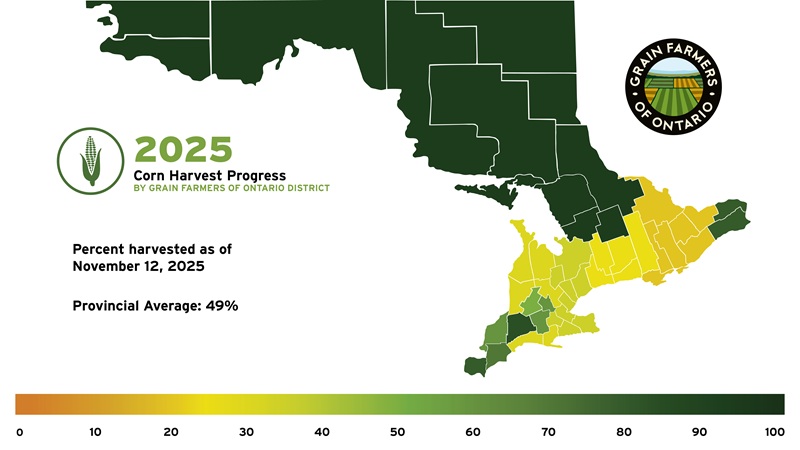
Field Progress is reporting that the Ontario corn crop is with 49 per cent harvested. A massive push occurred prior to the rain and snow arriving to get as many acres off as possible.
As harvest continues, yield loss is a common topic. It can have many different contributing factors:
- Germinating kernels. In early October, the corn looked great, with excellent quality with exceptional test weight. However, as the month advanced, rain ensured. The husks in upright ears held onto water and kernels sat in water for a prolonged period. Rewetting the kernels at the butt of the cob can cause kernels to germinate. Sometimes, green growth can be seen. But for the most part, germinated kernels are not evident until the cob is shelled, and the actual sprout and root are then visible. If dry weather again arrives, the kernels and husks will dry back out but the damage will be done — rewetting of the kernel caused the enzymatic active to burn the starch in the kernel and lose weight. Germinated kernels hit the combine and break apart, creating extra fines. This lowersi yields through loss of grain and with lighter test weight, compared to the same hybrid being harvested earlier before the rains arrived.
- Header loss
- Dropped ears from the wind
- Snow accumulation
- Improper combine settings
- Animal feeding and more can impact yield loss
Some fall tillage on corn stalks has started in drier areas.. Remember that soil compaction is a very real concern when fields are saturated. Learn more here.
And finally, keep an eye now on stalk integrity.
Soybeans
Most of the soybean crop has been harvested, with harvest 99 per cent complete, according to Field Progress.
Cereals
Spring cereal trial data from the Ontario Cereal Crop Committee has been released for spring wheat, spring barley and oats via GoCrops.ca.
Wheat fields are saturated with moisture, so monitor if plants have turned yellow or even brown due to saturated soils that limit oxygen exchange in the roots. If this occurs think about how will winter wheat will handle the winter with such saturated soils. Will high soil moisture at time of freeze cause damage to the plant?
In the past, where wheat went into the winter months surrounded by water and ice, the largest contributing factor for winter survival was the soil condition, structure and drainage. Wherever water laid and couldn’t drain through the soil profile, there was essentially no wheat in the spring. Basically, when soil is saturated, there is no ability for gaseous exchange and the roots suffocate. It may not look like the field is flooded, but poor soil aeration will cause plant death. In fields that have tile, wheat will come through over the tile runs better it does in areas between the tile runs, because the tile beneath allowed for drainage to occur and prevented root suffocation.
To determine if plants are dead, cut them in half and look at the inner tissue. If it’s white and looks like new green coming out of the new shoot area of the main plant or tillers, good conditions will allow plants to recover and continue to grow. If brown and yellow stands are observed the crop will be set back. But with favourable conditions the crop can still develop further and produce grain. Spring heaving and evaluations on wheat stands may be critical next spring in some areas.
Ongoing Soil Fertility Webinar Series
Join Grain Farmers of Ontario’s three-part GrainTALK Webinar Series focusing on soil fertility.
The first webinar covers the how, why and when of soil sampling. The second webinar is focussed on interpreting results, turning analysis into recommendations, credits for manure and cover crops, and tools to use. These webinars have taken place and can be viewed here.
The third webinar of the series takes place on Wednesday, November 19, @ noon. Colin Elgie, Ontario Ministry of Agriculture, Food and Agribusiness, and Dale Cowan, Agris Co-operative Ltd., will discuss how to take a recommendation and turn it into a fertilization plan.
*OFCAF KSE credits and CCA CEU credits are available.
While each webinar stands on its own, the series is designed to tell a complete story — from soil sampling to building a fertilization plan. Register for the third webinar here.
November 6, 2025
Soybean harvest is wrapping up, corn harvest is just over a third harvested. Be sure to keep an eye for stalk strength as November winds blow in.
Corn

Corn harvest continues steadily as weather allows. Field Progress reports that corn harvest is 39 per cent complete as of November 5, 2025. Harvest moistures are around the 20 to 30 percent range, with variability at the field level in harvest moistures. Several areas could be contributing to moisture variability, which was briefly highlighted last week; drought concerns, fertility, maturity date, frost impacts, field variability, and management all can come into play in influencing crop dry down at harvest. Now that the calendar has turned to November crop dry down will decelerate and, in some cases, halt.
The current concern is stalk degradation caused by fwet weather making plants heavier, as well as continued cellular breakdown of stalks. Expect more stalk lodging as the year continues, particularly in drought-stricken areas. More on stalk integrity and how to tell which fields should be harvested first here.
Keep an eye on grain quality with wet conditions occurring as water pooling in the upright corn ears can lead to sprouts forming on the lower part of the cob. Wetter grain, lower test weight, and more cracked grain will result.
As shared last week, the 2025 Ontario Grain Corn Ear Mould and Deoxynivalenol (DON) Mycotoxin Survey has now been posted. This year’s survey found that 98 per cent of samples tested low (below 2.00 parts per million (ppm)). For more general information on DON in corn view this factsheet.
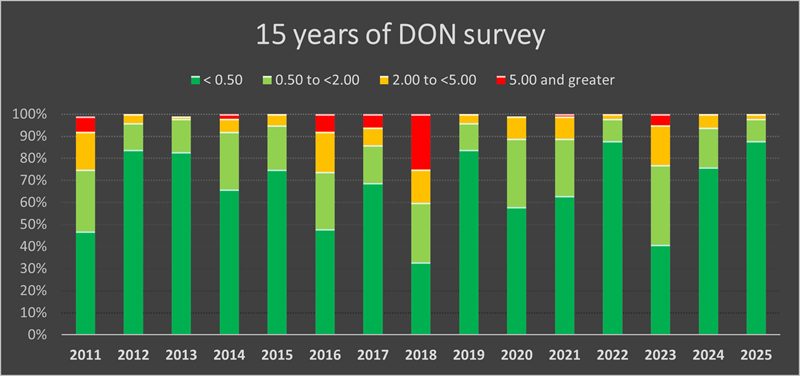
As the year has turned wet, soil compaction has become a concern as fields are harvested in sometimes less than ideal soil conditions. Read more here on the problem along with short and long term considerations.
As the harvest continues keep a watch out for weed escapes. The combine gives a great vantage point for what is hiding in corn fields, take note and make adjustments for the upcoming season. Also, should a field have a particularly hard to control weed, or a new weed to the area do make sure to try to clean out the combine prior to moving to a new field as to prevent seed spread.
Soybeans
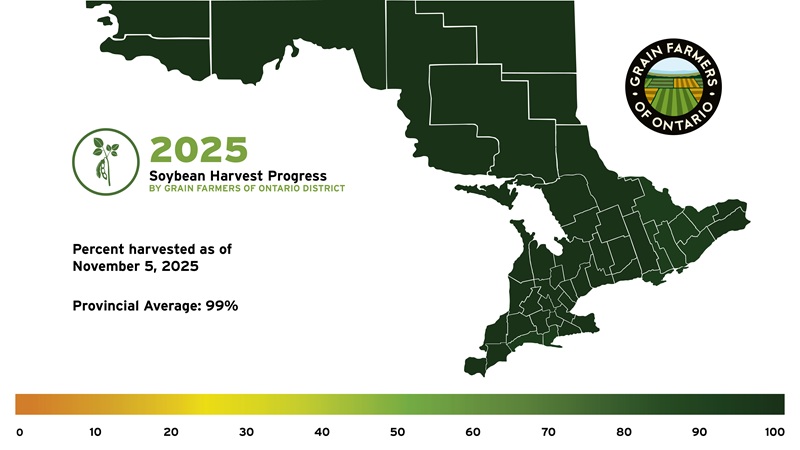
The soybean harvest is very close to complete, with Field Progress reporting 99 per cent complete. Any remaining soybeans will most likely be waiting until ground is frozen to complete harvest.
Cereals
Winter wheat continues to grow, staging at GS 21 to 22 (1 to 2 tillers). As temperatures begin to drop, winter wheat begins to acclimate to the cold. Certain genes within the wheat produce a substance that protects the cell membranes. In a wheat plant that has developed a minimum of four to five leaves and one to two tillers, cold acclimation begins when soil temperatures at the crown go below 10°C. If the plant is not at this stage, the lack of tillers heading into winter can result in an inadequate number of heads the following year, affecting yield. Tillers can still develop in the spring, but the yield potential may differ between tillers formed in the fall and tillers formed in the spring. It takes approximately four to six weeks with soil temperatures below 10°C at the crown depth for the wheat plant to fully harden. The colder the soil, the more quickly the plants develop winter hardiness. The fluctuating air temperatures that we are seeing also influence soil temperature to a point. Once the cold acclimation begins in the fall, wheat plants can unharden when soil temperatures at the crown go above 10°C and will re-harden when the soil at the crown goes below 10°C.
Ongoing Soil Fertility Webinar Series
Join Grain Farmers of Ontario’s three-part GrainTALK Webinar Series focusing on soil fertility.
The first webinar of the series focusing on Soil Sampling- the how, the why, and the when, with Colin Elgie, Danny Jefferies and Caleb Niemeyer occurred earlier this week, watch it now.
Topics for the second and third webinars are below. While each webinar stands on its own, the series is designed to tell a complete story — from soil sampling to building a fertilization plan. Register once for access to the series of webinars here.
Wednesday, November 12, @ noon
Christine Brown and Colin Elgie, Ontario Ministry of Agriculture, Food and Agribusiness, discuss: The interpretation of results, turning analysis into recommendations, plus credits for manure & cover crops, and tools to use.
Wednesday, November 19, @ noon
Colin Elgie, Ontario Ministry of Agriculture, Food and Agribusiness, and Dale Cowan, Agris Co-operative Ltd., discuss: How to take a recommendation and turn it into a fertilization plan.
*OFCAF KSE credits and CCA CEU credits are available.

October 30, 2025
Corn harvest picked up speed earlier this week after last week’s rain showers. Winter wheat planting wraps up, and soybean harvest is closer to completion as November draws near.
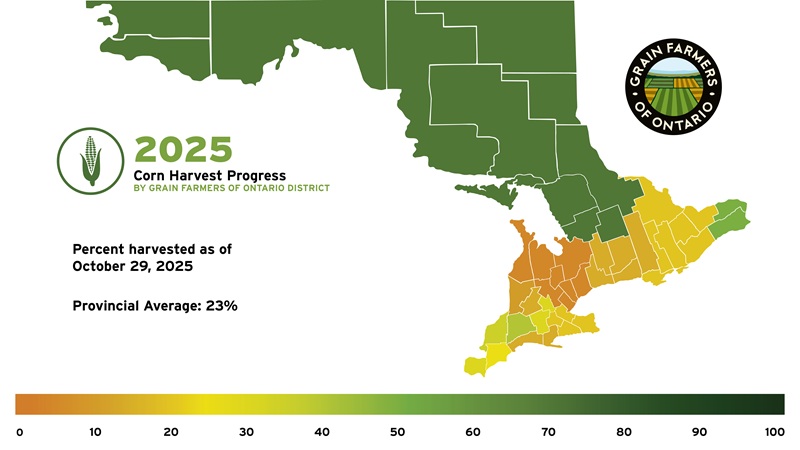
Over the past week, some areas have received large amounts of rainfall, over several days, stalling harvest slightly. Harvest of corn, as reported by Field Progress, is at 23 per cent complete as of October 29, 2025.
There has been some discussion on the drydown of the corn crop—there are a lot of influences.
- Weather
- Sun, rain, temperature, wind, and past solar radiation challenges (such as smoke) may slow down or increase the rate of crop development and dry down.
- Hybrid characteristics
- With respect to husk coverage, thickness, and the number of husk leaves, all can contribute to the rate of dry down.
- Field variability
- Subsoil differences and water holding capacity (e.g., gravel or sandy knolls or other variability in the field) can cause moisture variability across the field.
- Management
- Fungicide application(s), amount of nitrogen applied, and crop rotation can all impact the health of the plant throughout the growing season
Dry down in September may see 0.5 to 1 percentage points dry down per day, but as temperatures cool, dry down rates decrease as well, sometimes to no moisture loss. Also, should the crop shut down prior to black layer, the moisture content of the kernel will fluctuate.
The 2025 Ontario Grain Corn Ear Mould and Deoxynivalenol (DON) Mycotoxin Survey has now been posted. This year’s survey found that 98 per cent of samples tested low (below 2.00 parts per million (ppm). More on the survey can be found in the link.
Overall, soil moisture in the fall is often lower, allowing for proper soil fracturing when the ground is worked. When soil moisture is at field capacity or above, any travel over the field can cause maximum soil compaction. Working the ground when it is too wet can lead to compaction, ineffective soil fracturing, soil smearing, and the formation of large clods. So, tillage when conditions are not ideal can damage the soil, reduce the long-term soil quality, and reduce yields in future years. Read more on soil compaction, considerations and how to limit it in the fall here.
Pay close attention to corn germinating on the cob, as it can be another concern that might start to pop up a bit this fall, as moisture caught within the husks of upright ears has rewetted the kernels, leading to germination. If kernels were stressed or damaged during grain fill or have fungi present, there may be hormonal differences in the kernel that, with the right temperature and moisture, can be susceptible to sprouting.
As the seed selection season nears, there are several topics to keep in mind: agronomic package, seed treatments, appropriate traits (for insect resistance management and weed spectrum) and market considerations are all imperative to consider. More can be found here.
Soybeans
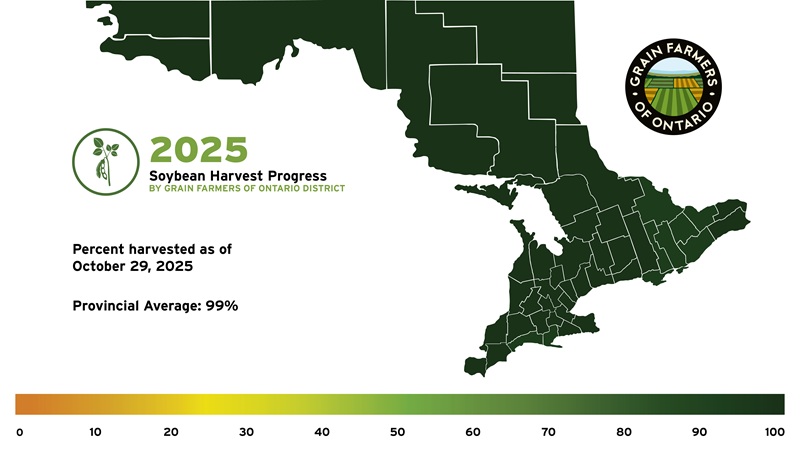
Soybean harvest has been stop and start over the past several days depending on the amount of rainfall received. Field Progress reports soybean harvest as 99 per cent complete as of October 29, 2025.
A reminder to ensure that treated seed is not contaminating grain handling equipment at harvest. A resource on handling treated seed and thing to consider can be found here.
Cereals
Winter wheat is staging at Growth stage 21 (main shoot plus 1 tiller). Tillers produced in the fall will contribute more to grain yield than those produced in the spring.

Field progress reports winter wheat planting at 100 per cent complete as of October 29, 2025.
A reminder to report planted winter cereal acres to Agricorp by November 8.
Mental health
There have been a lot of curveballs this season: weather, increasing costs, and crop yield. We are all in this together. Reach out to those around you and check in. It could be as small of a gesture as a visit or a call to a farming friend, or a quick check-in on your neighbours. If you have the ability to step away from it all for a few days, take that opportunity. If you are able, offer to help other neighbours with completing harvest or perhaps run for some parts. You never know when your time and care might make (or save) someone else’s day. Take advantage of any number of resources available.
Upcoming Soil Fertility Webinar Series
Join Grain Farmers of Ontario’s three-part GrainTALK Webinar Series focusing on soil fertility.
Wednesday, November 5, @ noon
Colin Elgie, Ontario Ministry of Agriculture, Food and Agribusiness; Danny Jefferies, Honeyland Ag Services; and Caleb Niemeyer, Woodrill Ltd. discuss: Soil sampling – The how, the why, and the when.
Wednesday, November 12, @ noon
Christine Brown and Colin Elgie, Ontario Ministry of Agriculture, Food and Agribusiness, discuss: The interpretation of results, turning analysis into recommendations, plus credits for manure & cover crops, and tools to use.
Wednesday, November 19, @ noon
Colin Elgie, Ontario Ministry of Agriculture, Food and Agribusiness, and Dale Cowan, Agris Co-operative Ltd., discuss: How to take a recommendation and turn it into a fertilization plan.
*OFCAF KSE credits and CCA CEU credits are available.
While each webinar stands on its own, the series is designed to tell a complete story — from soil sampling to building a fertilization plan. Register once for access to all three webinars here.

Field Progress
Field Progress– Grain Farmers of Ontario’s weekly estimation of planting and harvest across the province, by district, reports that winter wheat planting is 100 per cent, soybean harvest is at 99 per cent, and corn harvest is at 23 per cent as of October 29, 2025.
October 23, 2025
This week has been rainy which has slowed harvest—and there is more rain in the forecast. However, overall great progress has been made on both soybean harvest and winter wheat planting with corn harvest also occurring.
Corn
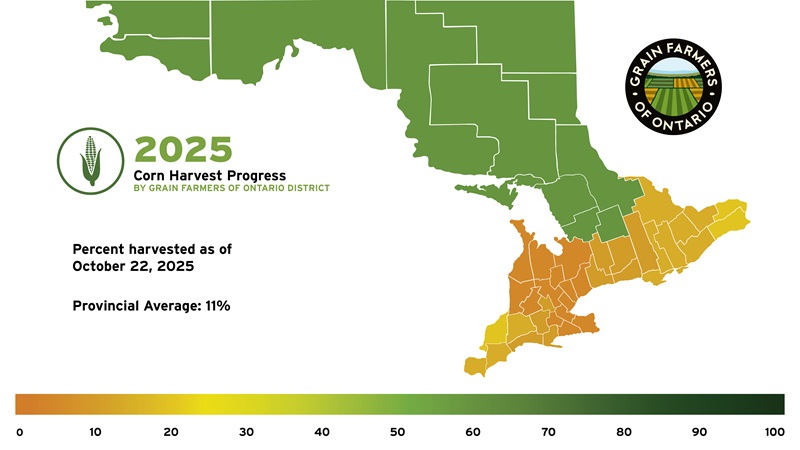
As regions are able, corn harvest continues to progress slowly, moistures are in the low 20s with some reaching high teens. Field Progress reports that corn harvest is 11 per cent complete as of October 22, 2025. Yields reported so far range from below average to above average, depending on the area.
Fields that saw ideal conditions, that didn’t have stress and stayed green until well past black layer (physiological maturity) show what is possible where there were uniform emergence and no stress throughout the year. If the plant is protected from weeds, disease, and insects and does not have drought impacts and is allowed to maximize kernel size with adequate moisture at grain fill it allows for top yields. Unfortunately, that does not seem to be the overall case this year, due to a lack of moisture in many areas. However, some areas experienced timely rains and good plant health and will see good to excellent yields.
Keep on eye on stalk integrity, as some fields are beginning to show stalk breakdown. Strong winds on Sunday have taken the tops out of some hybrids that were drought stressed this year. Aim to harvest those fields first before they lodge any further and cause a headache at combining time.
For those that are storing grain at home, ensure grain is dry, aerate grain regularly, and monitor your bins to help ensure grain condition when stored long-term. For some bin safety tips reference this past Ontario Grain Farmer article.
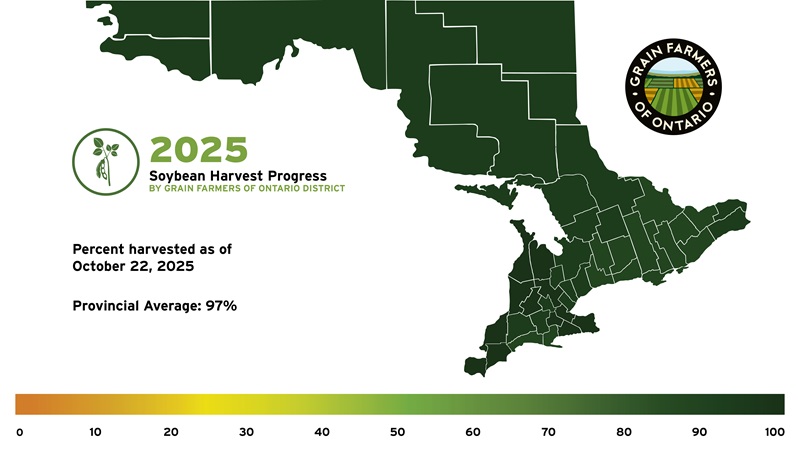
Soybeans
As mentioned in previous articles this soybean harvest was one for the books, weather wise, with a huge stretch of ideal harvest conditions overall. That might have ended as the long range looks like regular rains, as the remaining acres are harvested. Field Progress is reporting the soybean harvest as 97 per cent complete as of October 22, 2025. Yields reported have been well below average to above average depending on the region of the province.
Cereals
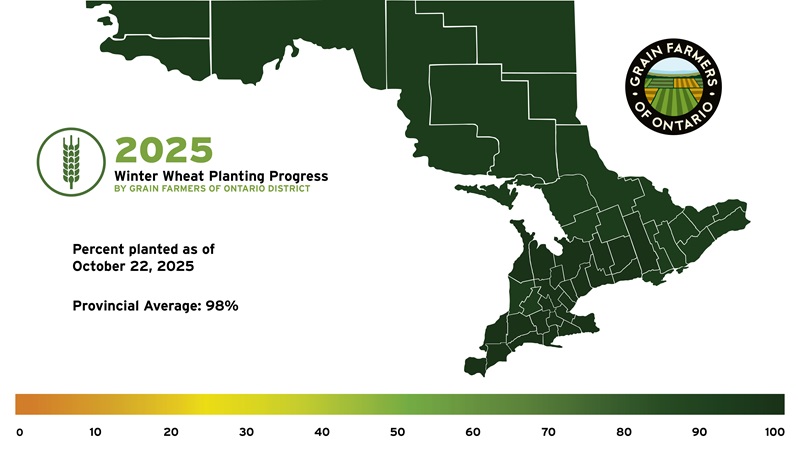
Overall, the winter wheat crop has had a great start. Some areas could have, of course, used more moisture, but many wheat fields have received timely rains after planting. Winter wheat is staging around the Growth stage 14 (4 leaves unfolded). Planting is wrapping up with Field Progress reporting as of October 22, 2025, that 98 per cent is planted.
Upcoming Soil Fertility Webinar Series
Join Grain Farmers of Ontario’s three-part GrainTALK Webinar Series focusing on soil fertility.
Wednesday, November 5, @ noon
Colin Elgie, Ontario Ministry of Agriculture, Food and Agribusiness; Danny Jefferies, Honeyland Ag Services; and Caleb Niemeyer, Woodrill Ltd. discuss: Soil sampling – The how, the why, and the when.
Wednesday, November 12, @ noon
Christine Brown and Colin Elgie, Ontario Ministry of Agriculture, Food and Agribusiness, discuss: The interpretation of results, turning analysis into recommendations, plus credits for manure & cover crops, and tools to use.
Wednesday, November 19, @ noon
Colin Elgie, Ontario Ministry of Agriculture, Food and Agribusiness, and Dale Cowan, Agris Co-operative Ltd., discuss: How to take a recommendation and turn it into a fertilization plan.
*OFCAF KSE credits and CCA CEU credits are available.
While each webinar stands on its own, the series is designed to tell a complete story — from soil sampling to building a fertilization plan. Register once for access to all three webinars here.

October 16, 2025
Soybean harvest and winter wheat planting are wrapping up or on the home stretch for many. Corn harvest has begun.
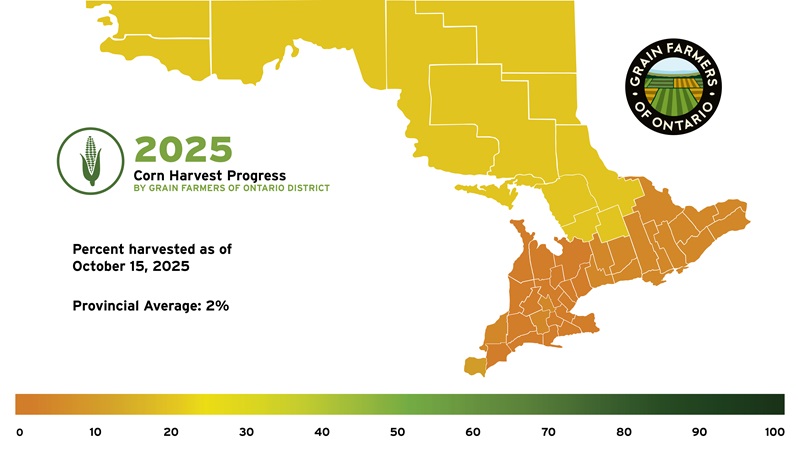
Corn
Much of the province received a frost late last week, which impacted the top portion of much of the corn plant, if it hadn’t already been hit by earlier frost, disease, or drought.
Over Thanksgiving weekend and into this past week, farmers have been harvesting corn in some areas. Field Progress shows that two per cent of corn is harvested as of October 15, 2025.
With harvest occurring early in the fall season, there is an opportunity to do some extra fall work to get ready for next spring. Warm open falls, if it can stay dry, can be an excellent opportunity for fall strip tillage and to apply some phosphorus (P) and potassium (K) for next year’s corn crop. The proper placement of fertilizer is one of the 4Rs of nutrient stewardship and is practiced by many farmers.
As harvest approaches, DON in corn is something to be aware of. Below are some resources on DON management.
General information:
- Factsheet: DON in Corn
- A comprehensive overview of DON mycotoxin and the resources available to manage its effects.
- Ontario Grain Corn Ear Mould and DON Mycotoxin Survey (Expected release: Mid-late October 2025)
- Published by the Ontario Ministry of Agriculture, Food, and Agribusiness (OMAFA), this annual survey provides an early assessment of DON presence in Ontario corn. The survey will be posted on Field Crop News.
Corn Hybrids:
- Ontario Corn Hybrid DON Screening Trials Report (Expected release: early 2026)
- This report – updated annually – offers vital data on the susceptibility of various corn hybrids to DON, assisting in both harvest decisions and seed purchases. The report will be posted on GoCrops.ca when it is available with 2025 data. Currently, 2024 data is available.
Proper DON testing procedures:
- Factsheet: Testing for DON
- Developed based on the findings of the DON Working Group, this guide outlines best practices for obtaining accurate DON test results. It emphasizes the importance of collecting a representative sample of at least two kilograms and grinding it to the correct size.
- Video: Accuracy in Testing for DON
- A step-by-step tutorial demonstrating best practices for accurate DON testing.
- Storing mycotoxin-affected corn grain:
- Factsheet: Storing mycotoxin-affected corn grain
- A comprehensive document that discusses harvest, drying and storage of mycotoxin-infected grain corn.
Soybeans
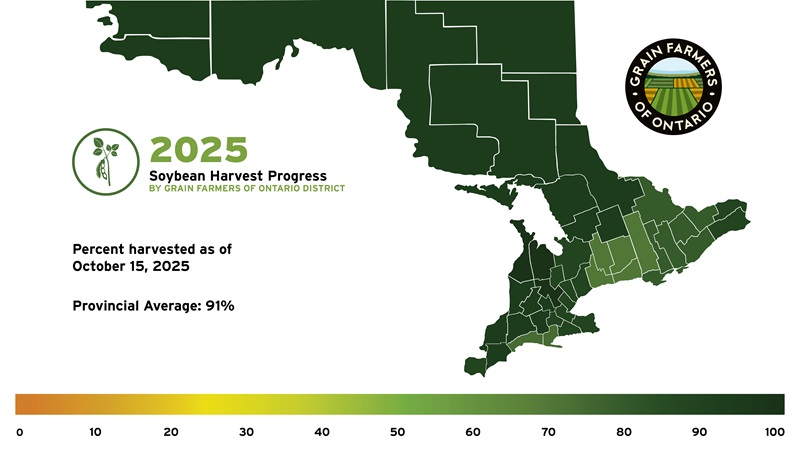
According to Field Progress 91 per cent of soybeans are harvested as of October 15, 2025.
It has been an incredible stretch of harvest weather and conditions overall; yields have been average to below average.
Double crop soybeans (planted in July after winter wheat) are approaching physiological maturity (R7) as the fields turn yellow and many leaves have fallen off. Physiological maturity in soybeans occurs when the seed is no longer attached to the pod, which in the corn plant would be equivalent to the black layer. If pods are cracked open and find the soybeans are still attached, then they are still susceptible to frost damage. As we have received very favourable temperatures this fall, the double crop soybeans are maturing naturally and seem to have avoided too much frost damage this year.
Cereals
Winter wheat planting progress is at 93 per cent as of October 15, 2025.

Wheat that was planted in ideal conditions at the end of September has established well in the past two weeks. Early tiller development before winter freeze up will allow this crop the potential for high stem and head counts. Wheat is staging up to GS 14 (4 leaves unfolded).
As of September 30, 2025, Ontario is still experiencing moderate to extreme drought conditions. A map can be found here, with further analysis by Ag Canada here.
Fall management
Mike Cowbrough, Weed Specialist – Field Crops, with the Ontario Ministry of Agriculture, Food and Agribusiness, has in the past shared his Top 5 Fall Weed Control Tips. These still hold true.
Upcoming Soil Fertility Webinar Series
Join Grain Farmers of Ontario’s three-part GrainTALK Webinar Series focusing on soil fertility.
Wednesday, November 5, @ noon
Colin Elgie, Ontario Ministry of Agriculture, Food and Agribusiness; Danny Jefferies, Honeyland Ag Services; and Caleb Niemeyer, Woodrill Ltd. discuss: Soil sampling – The how, the why, and the when.
Wednesday, November 12, @ noon
Christine Brown and Colin Elgie, Ontario Ministry of Agriculture, Food and Agribusiness, discuss: The interpretation of results, turning analysis into recommendations, plus credits for manure & cover crops, and tools to use.
Wednesday, November 19, @ noon
Colin Elgie, Ontario Ministry of Agriculture, Food and Agribusiness, and Dale Cowan, Agris Co-operative Ltd., discuss: How to take a recommendation and turn it into a fertilization plan.
*OFCAF KSE credits and CCA CEU credits are available.
While each webinar stands on its own, the series is designed to tell a complete story — from soil sampling to building a fertilization plan. Register once for access to all three webinars here.
Field Progress
Field Progress– Grain Farmers of Ontario’s weekly estimation of planting and harvest across the province, by district, reports that winter wheat planting is at 93 per cent, soybean harvest is at 91 per cent, and corn harvest is just beginning at 2 per cent harvested as of October 15, 2025.
October 9, 2025
October is here, a favourite month for many, as temperatures drop and fall colours abound. Soybean harvest continues, as does winter wheat planting, with corn harvest just around the corner for some.
Corn
Corn harvest will be approaching quickly for some, and has just slightly begun for other areas, as warm, dry weather has helped move along grain fill and dry down. Most of the corn will have reached black layer (physiological maturity) by this point in the season, with kernels now drying down to a harvestable moisture. Moisture content at black layer averages around 32 per cent. Grain dry down can be influenced by the tightness of the husk, the thickness of the outer portion of the grain (pericarp thickness), along with temperature and weather conditions.

Areas of northern Ontario have reported corn damaged by frost, in some cases prior to black layer, which can impact the quality and moisture of that corn.
As harvest approaches and begins, when out checking corn fields for moisture levels, make sure to look at stalk quality. A great way to do this is to push the corn stalk to a 45-degree angle. If it comes back up, great; if the stalk collapses and stays bent, target that field for early harvest. Another option is to kick the lower portion of the stalk, but do this carefully and only when wearing steel-toed boots. If it breaks, target for early harvest as well, but usually, as you walk through the field, you will get the clues if stalks are breaking when you cross over the rows. Stalk rots are a common culprit for poor stalk strength as well as plant cannibalization from leaf diseases, drought or nutrient deficiencies. Empty stalks leave no cellular structure to hold the plant up, and stalk collapse is inevitable once the winds come in. More on stalk integrity here.
Although these might not be as prevalent this year due to low moisture conditions, it is still important to be aware of stalk rots. Anthracnose is a dominant stalk rot disease that attacks the roots and stalks of plants that may have already shown some leaf disease. Spores from this fungus can remain alive for many years. When rain splashes the spores onto the lower stalk area, it makes shiny black spots, and then the stalks become black inside, rot, and fall over. Gibberella and Fusarium stalk rots are also caused by fungi that can live in the soil for many years. If the stalk is cut open with a knife (use caution when using knives), the inside of the stalk may have a pinkish colour, indicating that Fusarium and Gibberella may be present in the stalk. Many fields may be one strong windstorm from lodging.
The Ontario Grain Corn Ear Mould and Deoxynivalenol (DON) Mycotoxin Survey was conducted over the past couple of weeks. Grain corn samples are currently being analyzed for DON levels at the lab. A report from the surveyed fields will be available in the upcoming weeks.
Refresh your grain bin safety knowledge by listening to Grain Farmers of Ontario’s GrainTALK: Grain Bin Safety webinar. It is 30 minutes long and could save your life.
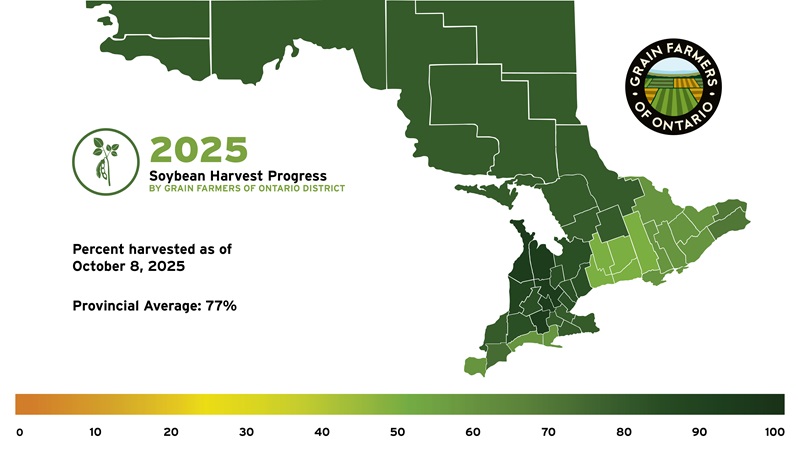
Soybeans
The past week has again seen incredible harvest conditions. Field Progress reports that 77 per cent of the soybean harvest has been completed, as of October 8, 2025.
Yields in some fields are below average, where moisture was limited, with others around average. With sunny, dry days, soybean harvest moisture has also been on the lower end of what some may prefer, with some fields coming off at eight per cent moisture.
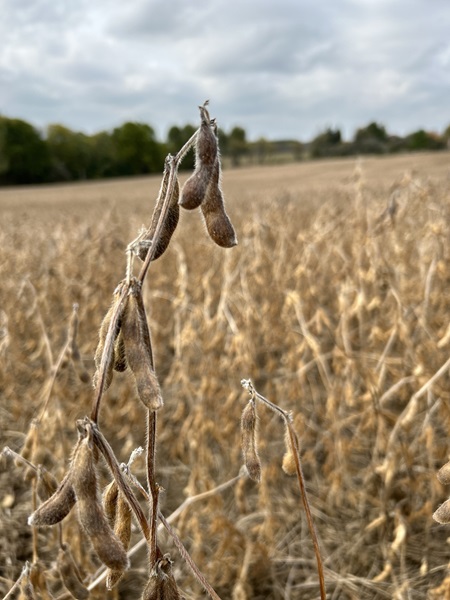
There has been some discussion on whether it is a good idea to pause soybean harvest and wait for harvest moistures to increase after a rain. The general consensus is to continue with harvest, as the good weather window could change at any point, and getting winter wheat planted timely and into good conditions is also a key consideration.
Pay particular attention to weed escapes that are being found in soybean fields at harvest, to better prepare for next year’s herbicide decisions. If there are weeds of concern that are challenging to identify, consider getting them identified by a local agronomist or connect with Mike Cowbrough, weed specialist, OMAFA. Some fall management tips were also shared in the past, from OMAFA, and can again be found here.
Cereals
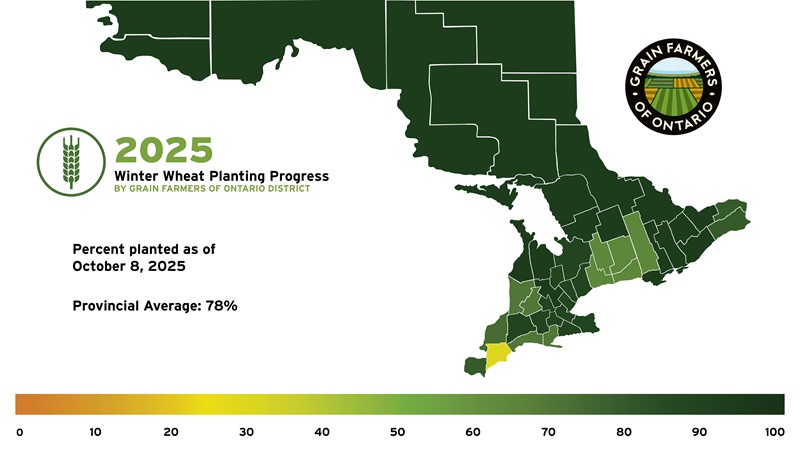
Field Progress reports winter wheat planting at 78 per cent complete, as of October 8, 2025. Now that the calendar has flipped to October, the winter wheat planting window has closed or is closing very quickly across the province. If planting past the optimum planting date, increase the rate by 100,000 seeds per acre per week. Optimum planting dates for winter wheat can be found here.
Agricorp planting deadlines for fall-seeded grains can be found here.
The deadline to submit yields for spring grains and spring wheat is October 31, 2025.
October 2, 2025
Another beautiful week, weather-wise, allowed many to start or continue soybean harvest. Winter wheat planting is also continuing.
Corn
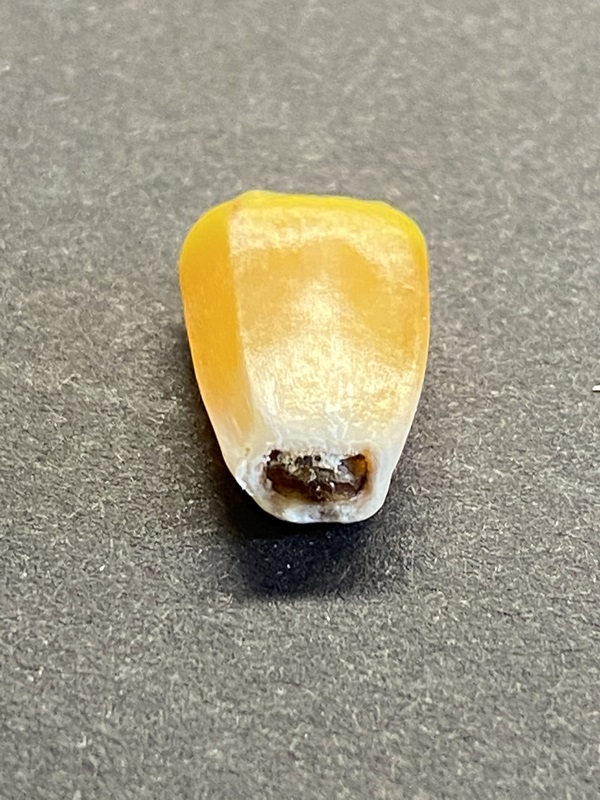
Corn in some regions has reached black layer, while in other areas, it is in a later stage of grain fill.
For fields that still had green leaves in the past few weeks, the plants were able to fill the kernel completely, adding test weight. Plants that have turned brown may have succumbed to an early death due to drought and heat stress. These fields will need to be monitored and evaluated for harvestability and early stalk lodging.
Complete a stalk strength test by pinching, bending, pushing, or kicking the stalk; all forms of stalk testing are good. If stalks break easily with the push test, schedule these for an earlier harvest, as winds in the fall will make these fields prone to lodging, and field grain losses will be greater—more on stalk integrity in this Grain Farmers of Ontario factsheet.
As many approach corn harvest, if you have concerns about potential DON testing, check with your local elevator to learn how they conduct their DON sampling procedures. DON levels in many areas are likely to be at low levels this year; however, it can still be present in some hotspots where weather conditions were ideal for Fusarium development. Ideal sampling at elevators involves taking a two-kilogram corn sample to grind and then pulling a homogenized subsample of the ground corn to run the Eliza test (dip test). To learn more about the ideal testing procedure, watch here.
Soybeans
Late last week, soybean harvest was occurring across much of the province. Field Progress reports that 39 per cent of harvest is complete as of October 1, 2025.
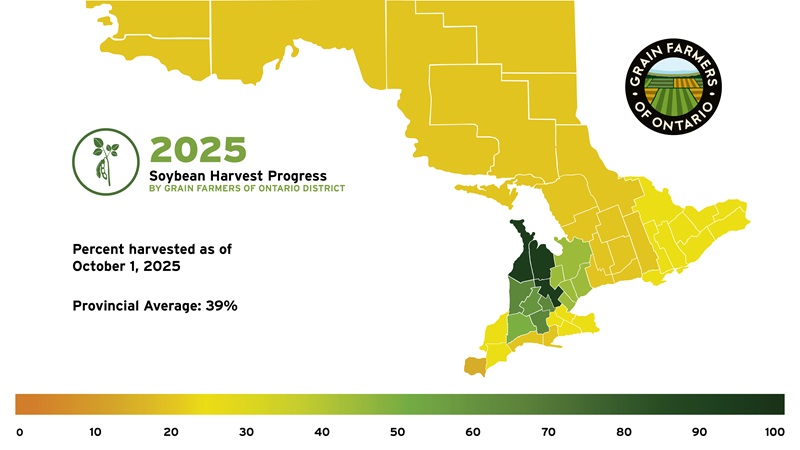
Moisture ranges have been anywhere from nine to 16 per cent, recent rains helped bring moistures up, which was appreciated. Yields range from below 20 to above 70 bushels per acre on excellent ground that received timely rains. Some farmers have been surprised at how low seed moistures are this fall as the soybean plant had just matured with lower leaves still attached. Higher temperatures and dry weather have led to quicker seed maturity and drydown, resulting in earlier full plant death this month.
When soybeans are under 13 per cent, elevators don’t adjust the weight up for dry soybeans, so shipping too dry soybeans is like giving a percentage of your beans away for free. Even paying a little for drying charges and taking a bit of shrink for wet soybeans just to get them off the field and into the bin is always worth it compared to the weight lost from dry soybeans and a delayed harvest. Additionally, future weather predictions are sometimes incorrect for clear days to harvest, so waiting for perfect moisture at 13 per cent will not be feasible on many fields. By getting the soybeans off the field in a timely manner, it also allows wheat to be planted in close to ideal conditions without ending up mucking in the seed later in cooler conditions when seasonal weather occurs.
As harvest continues, residue management is key for optimum seedbed prep for winter wheat. More from OMAFA here on soybean residue management.
Another thing to consider is safety, along with mental health, throughout the harvest season. Giving a little extra room for harvest and planting allows for less stress to be put on farmers and employees, with more flexibility and the potential for more sleep. Working while overly tired is as dangerous as impaired driving.
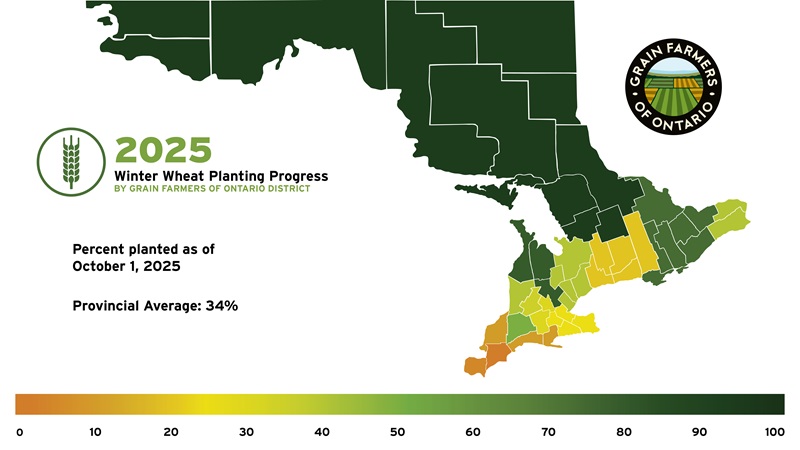
Cereals
Field Progress reports that winter wheat planting is at 34 per cent complete as of Wednesday, October 1, 2025
The winter wheat that has been planted has gone into near-ideal conditions, with warm soil temperatures and good soil moisture, which has helped germinate the seed.
If planting much earlier than the optimum planting date, backing off on the population is advised, as good plant growth and tillering can be expected with the warmer fall predicted. If planting at ideal dates, the population should be at normal levels. Later planting dates will require higher populations to compensate for reduced plant growth and fewer tillers. Planting populations range from 1.2 million to 1.8 million seeds per acre, depending on the planting time, soil type, and management practices. Always verify your seed source and adjust the population according to the tested germination rate. If planting by pounds per acre, as that is how the drill is set up, ensure you check the seed size and adjust the number of pounds you are seeding accordingly. Based on the variety and environment in which the seed was grown, seed lots can vary by up to 3,000 seeds per pound. If seeding 103 pounds to the acre, this could mean a difference of close to 400,000 seeds per acre. Which, in turn, could mean a too-thin stand or a way too thick stand that may be more prone to disease and lodging. Be sure to adjust the planter.

Spring cereal harvest according to Field Progress reports that harvest is 100 per cent complete.
Environmental Farm Plan
The 5th edition of the Environmental Farm Plan (EFP) is now available. The updated edition incorporates current regulatory requirements and the latest scientific findings on BMPS. 4th edition EFPs will be accepted for Sustainable Canadian Agricultural Partnership (SCAP) until March 2028. Other organizations may request a more current EFP to support their compliance and/or funding programs.
Grain Farmers of Ontario recently launched Field Progress—your go-to source for weekly estimation on planting and harvest progress across the province, by district.
Right now, you’ll find the latest for soybean harvest and winter wheat planting progress.
And as the season rolls on, Field Progress will spotlight corn harvest progress—with spring planting updates coming next year!
September 25, 2025
As a new season arrived, so did a much-needed rain for the vast majority of southern Ontario. The corn milk line is progressing towards black layer, while the soybean harvest has had a strong start, as has winter wheat planting.
Corn
Corn milk line progression is between ½ and 7/8 milk line. The warmth of the past week really helped milk line progression move along. Black layer will be reached in the coming days for some hybrids.
Silage harvest is ongoing. Remember, silo gas with silage harvest can be a significant concern, especially in drought-stricken areas. For more information on risks and management from OMAFA, please visit here.
Soybeans
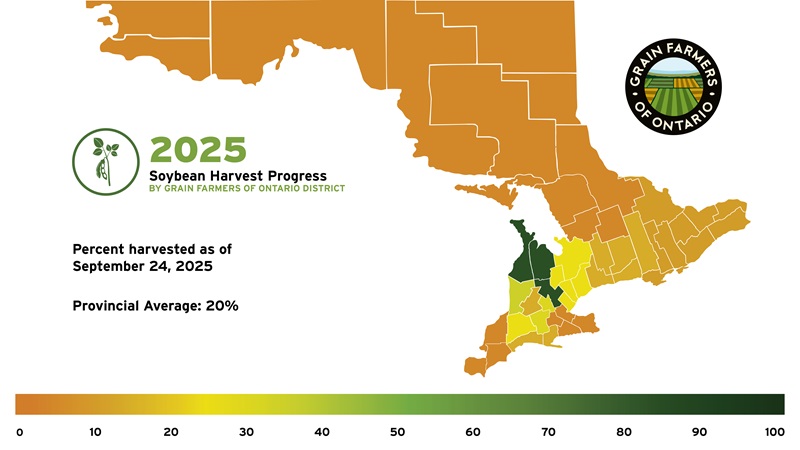
The soybean harvest rolls on with as close to perfect weather as anyone could ask for, up until Sunday night—sunny, warm days followed by a well-timed rain. The rain will help even out mature soybean fields and raise the seed moisture in areas that experienced early maturity within fields. Field Progress shares that the soybean harvest is at 20 per cent complete, as of Wednesday, September 24, 2025.
As soybean fields are harvested, it is a great time to test them for Soybean Cyst Nematode levels. Sampling is an important part of managing the pest, along with variety choice and crop rotation to a non-host crop. Ideally, fields should be sampled every 3 years. More on sampling and the implications of SCN on soybeans can be found here.
Are there suspicious weeds being found in soybean fields? A good first step is to consult with a local agronomist to help identify the weed and determine its potential causes.
For further insight, two testing services are available in Ontario to determine if plants are herbicide-resistant.
Plant bioassay testing by the University of Guelph– This service is offered through the University of Guelph, and requests mature seed collected in the fall to be submitted. Due to the seeds required, this is a great option later in the fall if plants have been frost-damaged but have viable seeds. Plants are then grown from the seed and sprayed with various doses of the herbicide(s) that are suspected to be resistant to. Results are typically provided by April. The service is provided at no cost to Ontario farmers.
Molecular testing by TurnKey Genomics (private lab) – The molecular testing service requires plant tissue that is roughly “loonie-sized”, so a single leaf is often adequate. Results are shared in a matter of days. Grain Farmers of Ontario helps fund some of this testing through OMAFA.
With respect to perennial weeds, there is an excellent article from OMAFA on fall herbicide applications and maximizing the impact on perennial weeds shared here.
Cereals
According to Field Progress, the spring cereal harvest is 91 per cent as of September 25, 2025. Winter wheat planting is at 13 per cent as of September 25, 2025. A well-timed rain this past week has helped any wheat that is in the ground germinate.
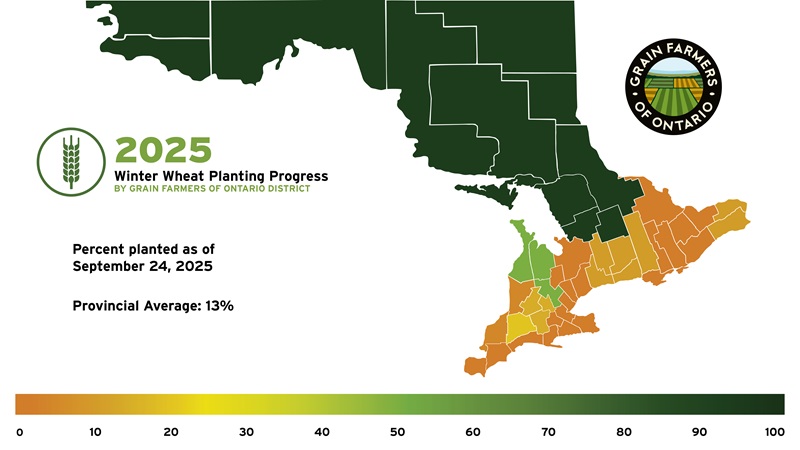
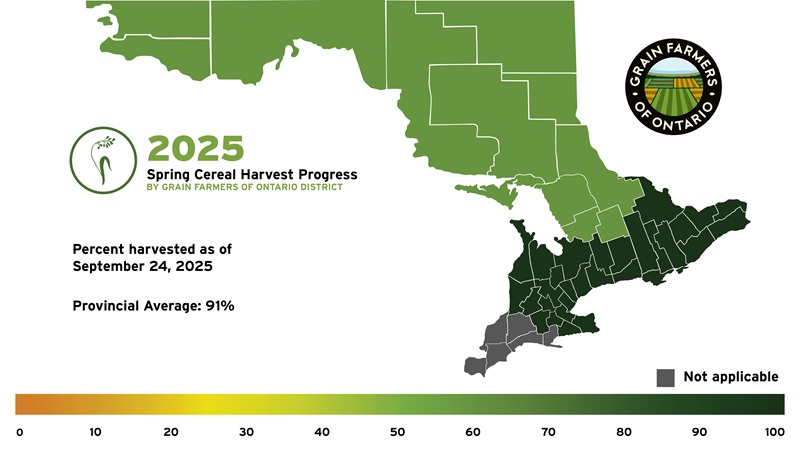
Mental health
As the fall arrives, take time to celebrate successes, whether big or small. Harvest is a stressful time of year. Be sure to take the time to get the support needed. Several support resources are available here.
